(±)11-HETE is an oxylipin formed non-enzymatically from arachidonic acid .
1,2 Levels of (±)11-HETE are increased in an
in vitro model of lipid peroxidation induced by ferrous ammonium sulfate (FAS) in rat brain homogenates.
3 Levels are also increased in rat liver in an
in vivo model of lipid peroxidation induced by carbon tetrachloride (CCl
4). It has been found in skin extracts from individuals with psoriasis and in atherosclerotic plaques.
4,5
1. Powell, W.S., and Rokach, J. Biosynthesis, biological effects, and receptors of hydroxyeicosatetraenoic acids (HETEs) and oxoeicosatetraenoic acids (oxo-ETEs) derived from arachidonic acid Biochim. Biophys. Acta 1851(4),340-355(2014).
2. Derogis, P.B.M.C., Chaves-Filho, A.B., and Miyamoto, S. Characterization of hydroxy and hydroperoxy polyunsaturated fatty acids by mass spectrometry Bioactive lipids in health and disease ,21-38(2019).
3. Guido, D.M., McKenna, R., and Mathews, W.R. Quantitation of hydroperoxy-eicosatetraenoic acids and hydroxy-eicosatetraenoic acids as indicators of lipid peroxidation using gas chromatography-mass spectrometry Anal. Biochem. 209(1),123-129(1993).
4. Camp, R.D.R., Mallet, A.I., Woollard, P.M., et al. The identification of hydroxy fatty acids in psoriatic skin Prostaglandins 26(3),431-447(1983).
5. Waddington, E., Sienuarine, K., Puddey, I., et al. Identification and quantitation of unique fatty acid oxidation products in human atherosclerotic plaque using high-performance liquid chromatography Anal. Biochem. 292(2),234-244(2001).
